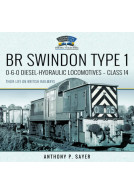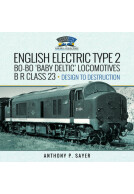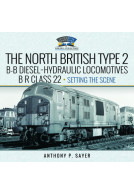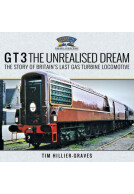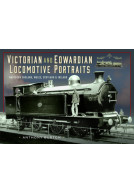BR Swindon Type 1 0-6-0 Diesel-Hydraulic Locomotives - Class 14 (Hardback)
Their Life in Industry
Imprint: Pen & Sword Transport
Series: Locomotive Portfolios: Diesel and Electric
Pages: 296
ISBN: 9781399019170
Published: 8th June 2022
(click here for international delivery rates)
Order within the next 11 hours, 7 minutes to get your order processed the next working day!
Need a currency converter? Check XE.com for live rates
In 1957 the Western Region of BR identified a need for 400 Type 1 diesel locomotives for short-haul freight duties but it was 1964 before the first was introduced. General-purpose Type 1s were being delivered elsewhere but WR management regarded these as too expensive for their requirements. After completion of design work on the ‘Western’ locomotives, Swindon turned to creating a cheap ‘no-frills’ Type 1. At 65% of the cost of the Bo-Bo alternative, the Swindon 0-6-0 represented a better ‘fit’ for the trip-freight niche. Since 1957 the privatised road-haulage industry had decimated BR’s wagon-load sector; whilst the 1962 Transport Act released BR from its financially-debilitating public-service obligations, the damage had been done, and the 1963 Beeching Plan focused on closing unprofitable routes and associated services. By 1963 the original requirement for 400 Type 1s had been massively reduced. Fifty-six locomotives were constructed in 1964/65. Continuing traffic losses resulted in the whole class becoming redundant by 1969. Fortuitously, a demand for high-powered diesels on the larger industrial railway systems saw the bulk of the locomotives finding useful employment for a further twenty years. This companion book to "Their Life on British Railways" provides an extensive appraisal of "Their Life in Industry" for the forty-eight locomotives which made the successful transition after withdrawal from BR in 1968/69.
As featured in Bookshelf pages
Best of British
"There is a great level of detail and photos of each workhorse included here. Fascinating."
Best of British Magazine - April 2023
Inside is the most extensive published work on Class 14s in industry with illustrations, tabulated data, complete dates and records, plus information and maps about the coal and steel sites at which they worked. Comprehensive.
Trackside magazine
Featured by
The Broad Gauge Society
With such a cuddly-sounding nickname, BR’s Type 1 diesel-hydraulics (later Class 14) have certainly been popular with enthusiasts since their introduction in 1964. Designed by the Western Region primarily for trip freight work, a fleet of 56 locomotives was constructed at Swindon Works. Alas, with freight traffic levels plummeting, the fleet was rendered redundant before the decade was out.
Model Rail Magazine
Industry came to the rescue, however, with 48 locomotives taken on by a range of employers, most notably the National Coal Board. Examples also worked at cement works, oil refineries, quarries and steel works around the UK, with many finding their way into preservation and some even working abroad.
Anthony P Sayer’s two volumes offer a comprehensive history of the fleet as a whole and individually, across their BR and industrial careers. Indeed, virtually everything you need to know about the Type 1s is presented in these copiously illustrated - and attractively produced - hardback volumes.
Modellers will appreciate the lists of detail differences, liveries and numbers, allocations and modifications for every locomotive. Photographic coverage of all examples is also impressive. With RTR Class 14s now available in ‘N’, ‘OO’ and ‘O’, these books provide the perfect companion to a miniature ‘Teddy Bear’. Highly recommended.
Following from the author’s account of the brief and unsuccessful life of these locomotives in British Rail service, he now offers a history of the life of each engine in industry.
Welsh Railways Research Circle Newsletter No.171, Autumn 2022
Forty eight of the fifty six built went to industry where they proved successful. Most went to British Steel in the East Midlands and others to the National Coal Board in the North East. A few found work in Wales, at Ebbw Vale tinplate works, NCB Mardy colliery and Gulf Oil refinery, Milford Haven. Some were exported and fourteen survived into preservation.
The author offers a list of locations for each engine, their histories and eventual disposals showing remarkable dedication and attention to detail for a small class that perhaps should never have been built. One for the industrial railway buff.
Review as featured in
Rail Express
The present volume forms part two of the author’s work, the first part having covered the locomotives during their time in BR service. In line with the first part, the author has succeeded in bringing together a vast amount of detailed information on the later lives of the widely dispersed fleet, including the various owners and sites at which they worked, details of sightings at works visits, disposals and observations from the staff using and maintaining the locos. Once again, there is a lengthy section covering each individual loco, and in this work we also find extensive chapters about the major National Coal Board areas where the locos could be found, as well as those of the British Steel Corporation and other users. The section dealing with the NCB operation in their Durham and Northumberland areas on its own runs to 75 pages and provides an in depth insight into the way the locos were used, and some of the problems encountered by staff. A nice touch is that location maps are provided showing the lines and collieries where the fleet worked.
West Somerset Railway Association
The whole of the book is enlivened by both black and white and colour illustrations, and while several of these show locos in run down or even cannibalised condition against a backdrop of rather dreary industry, they provide a picture of the day to day conditions they encountered. Perhaps the most colourful of the locations illustrated is the system around the British Steel works at Corby, where lineside trees and grassy banks are much more in evidence than on the NCB lines.
The author is generous in his tributes to the Industrial Railway Society and the photographers who were able to access these mostly unglamorous industrial sites, who together provided much of the source information used. This two part work was clearly a labour of love for the author, and it is sure to become the standard reference work on the Class 14s.
Review as featured in
Railways Illustrated
Highlight: 'The amount of detail and level of research is impressive, and this series of books is invaluable for anyone interested in modern traction history.'
"This book is a comprehensive study of the twenty years or so that this class saw industrial service. Profusely illustrated, and with a number of site maps. Highly recommended."
Industrial Railway Society Bulletin, July 2022
Another great book by Anthony Sayer. An in depth look at this class of locomotive
James Simmonds
Recommended
About Anthony Sayer
ANTHONY SAYER is a life-long railway enthusiast with an interest in the history of the early British diesel and electric locomotive classes. This is the author’s sixth book in the “Locomotive Portfolio” series, following on from the North British Type 2 (Classes 21 & 29), the Metropolitan-Vickers Type 2 (Class 28), the Clayton Type 1 (Class 17), the BTH/NBL Type 1 (Classes 15 & 16) and BR Swindon Type 1 (Class 14: Their Life on British Railways) books published between 2019 and 2021. Anthony lives in the north-east of England and has now retired after 37 years in the steel industry with responsibilities in both transport planning and supply-chain logistics.











